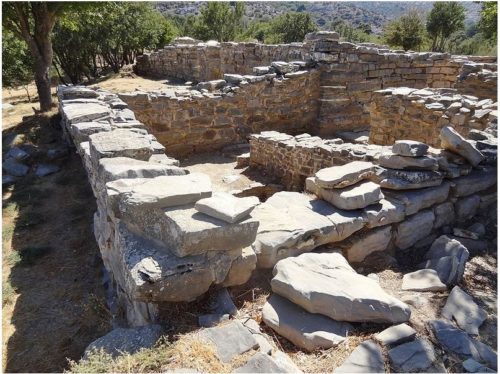As some Pagans and Heathens attempt to revive ancient or indigenous religions they often rely on the work of historians, primary texts and archaeologists. For this reason, when something new pops up that challenges long held academic ideas on cultural or religious practice, we pay attention. Here are some of the new(er) finds making waves in archaeological circles.
Zominthos at Crete
ZOMINTHOS, Crete — In the early 80s, archaeologists found a complex structure at Zominthos in Crete. The Archaeological Institute of American maintains an active website about this site with field notes from 2005 through 2018.

Ruins at Zominthos [website]
The structure sits on the mountain path from Knossos to the sanctuary cave at the peak of Mount Ida. Rhea hid the infant Zeus from Kronos in that cave. The mountain is sacred to both Rhea and Zeus. The structure may have served as a way-station on a sacred journey up the mountain. The Minoans held ritual feasts at this site.
They also used the building for administrative, religious, and artisanal purposes. Archaeologists have found metal working, ceramics, rock crystal, and copper smithing workshops. They have found large amounts of painted plaster. This suggests the presence of many frescoes.
The Hyksos
TELL EL-DAB’A, Egypt – An article in Archaeology magazine discusses a new interpretation of the Hyksos. They ruled Egypt between the collapse of the Middle Kingdom and the New Kingdom. Ancient Egyptians referred to the Hyksos, like the Roman nobility of the 6th Century referred to the Goths. This revisionist interpretation of the Hyksos has generated controversy. It presents an interpretation that has implications for the evolution of Pharaonic Religion.
An excavation site in the Nile Delta, Tell el-Dab’a, may be the ancient Hyksos capital, Avaris. According to these revisionist archaeologists, the Hyksos did not invade Egypt. Instead they theorize a cumulative immigration from the Levant. Climate change drove this migration.
In 2200 B.C.E. the global temperatures dropped. For the next two centuries, Egypt experienced severe drought, leading to political instability. The Levant and the rest of North Africa also experienced this drought.
Canaanite speaking migrants poured into Egypt. They settled in the Nile Delta and set up a trading network. They brought the horse and the chariot into Egypt. Other cultures in the Levant began to show Egyptian influence around this time. For the first time cultures outside of Egypt began to influence Egypt. They began to be called the Hyksos.
The Hyksos brought their religious practices into Egypt. After 1800 B.C.E., Temples to Syrian storm gods appeared in Avaris. Their temples differed in architecture from Egyptian temples. They introduced Baal into Egypt. For the Hyksos Baal was a god of trade, kingship, and the sea. The Hyksos appear to have linked Baal with the Egyptian god of the desert, Set. Egyptians had associated Set as the god of foreigners.
Deerskin divinatory calendars
SAN BARTOLO YAUTEPEC, Mexico — Cicely Winter was examining an old box in a church. Among the expected church books, she found one book, bound with much older material. The older material, made of deerskin, contained two rows of symbols and human figures. The images were similar to those of Mixtec divinatory calendars stored in the Vatican.
Someone had saved those pieces of deerskin from the Spanish cultural genocide. They, or someone else, had recycled that deerskin.
Ancient Beer in Raqefet Cave
HAIFA, Israel. Archaeologists have discovered evidence of beer brewing from 11,000 B.C.E. in the Raqefet Cave near Haifa, Israel. The Natufians (13,000 B.C.E. to 9,500 B.C.E) used this cave as a burial site. The researchers also found evidence of food preparation at this site. Archaeologists theorized that the Natufians ate and drank beer as part of their funerary practices. Before this discovery, no one had found evidence of beer before 6000 B.C.E. Wheat and barley formed the grain base of this beer. Brewers had added plants and legumes to the brew.
Many steps had to occur to transition from hunting gathering to settled agriculture. Archaeologists credit the Natufians with making many of those steps in that transition in this part of the world.
Historians have two theories about the invention of beer. Both theories involve the regular planting of cereal crops. According to one theory, baking bread came first. Brewing beer was a byproduct of baking bread. According to the other theory, people began to plant grain to secure a steady supply for brewing beer.
Archaeological resources:
- Archaeology, a magazine of the Archaeological Institute of America
- Interactive digs publishes field reports from the following active archaeological digs: at Achill, Ireland; Zominthos, Crete; Ferrycarrig, Ireland; Pompeii, Italy; Johnson’s Island, Ohio; and Jodensavanne, Suriname.
- The BBC offers videos that use CGI effects to travel to the Great Pyramid, the Athenian Acropolis, and Haga Sophia. These videos provide drone like view from above and inside. For people in the UK, it provides even more online Videos.
- Steve Saylor wrote the ancient Roman detective series about Gordianus the Finder. He also has a website “New & Forthcoming Ancient World Movies & TV shows 2018″ While not history, ancient world does meet pop culture here.
The Wild Hunt is not responsible for links to external content.
To join a conversation on this post:
Visit our The Wild Hunt subreddit! Point your favorite browser to https://www.reddit.com/r/The_Wild_Hunt_News/, then click “JOIN”. Make sure to click the bell, too, to be notified of new articles posted to our subreddit.
